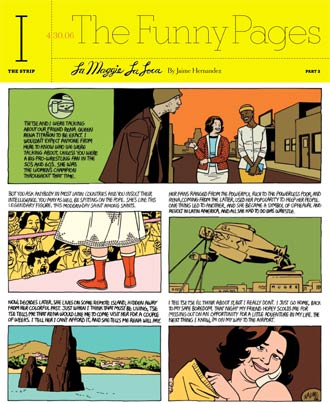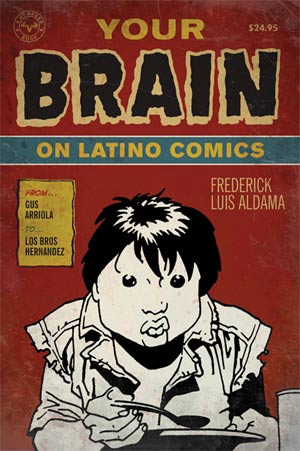
The study of mind through cognitive science and the findings of neurobiology have shed very interesting light on the way comic books are produced and read. I find this fascinating and have used it in my study of the visual and verbal elements at work in comic books by and about Latino and Chicano artists and authors. The result is Your Brain on Latino Comics, the first study of Latino comic books.
Your Brain on Latino Comics is a critical study of Latino comics. But an important feature of it is the inclusion of twenty-one interviews with the actual author/artists of Latino comics. The book joins the theoretical apparatus with the actual practice and experience of the author/artists themselves.
I organized the book in this way to allow a deep engagement for those who are interested in this storytelling form a critical perspective as well as for those interested in an actual practice perspective. Moreover, what we know of Latino comics, and what we know about how our brains process visual and verbal information from panel to panel, both enrich our pleasure in the actual experience of comics – Latino comics and comics generally.
“I’m particularly interested in questions such as why author/artists do know that a bold faced word is louder than a non bold-faced word.”
Part of developing our taste for certain comic books—and the same applies for novels, music, art, films, and the like—is our refining of our aesthetic sensibility. This typically happens at an early age. In the case of comic books, this is partly so because, for those like myself, and in terms of pocket money, it is much more possible to buy a comic than to buy a novel or to pay to see a film. The implications are, however, foundational. It is our developing of aesthetic faculty, our “growing,” that leads us to discriminate between likes and dislikes in all aspects of everyday life and in all age groups.
In Your Brain on Latino Comics I’m particularly interested in questions such as why author/artists do know that a bold faced word is louder than a non bold-faced word. Why do we imagine movement in the spaces (gutters) between the comics as well as within the panels proper? Why do we each have our own tastes in terms of certain styles of writing and drawing?
The book turns to advances in the brain sciences to give more formal expression to development of a taste faculty, as expressed in the likes and dislikes of Latino comic books, and also to a deeper understanding of what we do, and how we imagine, when consuming them.
Your Brain on Latino Comics provides readers with an understanding of how comic books in general work to move us and to engage our critical faculties and imagination. It also opens our eyes to how authors of Latino comic books (and comic strips by the likes of Gus Arriola and Lalo Alcaraz) choose to tell stories in any number of genres and styles: from the superheroic to the domestic, to the bitingly political and satirical.
We see in such choices also how author/artists of Latino comics overturn preconceptions of Latinos—not only as represented in mainstream DC and Marvel comics since the first appearance of Firebird (Marvel) and El Dorado (DC) in the late 1970s, but also in the sense that Latinos in comics are much more than Spanglish-speaking, taco-eating, pre-Columbian-ancestrally connected figures. Just as their creators, they represent the full and rich range of human experience and personality types.
Moreover, such author/artists defy such pre-packagings of Latinos precisely because their ambition is to tell and draw the best story possible—stories that they want to be judged along with the best. As the interviews attest, making a good comic book about Latinos is less about blood quantum than about responsibility to creating an engaging story, in form and content.
To refer to one of the interviews included in the book, when people see Frank Espinosa’s last name, they jump to the conclusion that all he knows is Latino culture. But he insists that he also knows about Ancient Greek literature, Japanese art, and all the rest. All the author/artists here seek to shed the straightjacket of identity politics that constrain their imagination.
All while recounting the history of how Latinos have been represented in mainstream comics, and creatively imagined by author/artists working today, Your Brain on Latino Comics also tells something about how author/artists of Latino comics infer inner states of mind, emotion and thought, from outward gesture and expression.

“Making a good comic book about Latinos is less about blood quantum than about responsibility to creating an engaging story, in form and content.”
From the very get-go when I conceived of the book, I felt a strong impulse to join critical analysis together with a polyphony of actual author/artists of Latino comics speaking about the craft. As a result, I was able to interview author/artists such as Laura Molina, Rafael Navarro, Roberta Gregory, Frank Espinosa, and Los Bros Hernandez, to name a few.
Your Brain on Latino Comics is the realization of my ambition: to offer a solid understanding of how Latino comic books work, as well as to give readers a firm grasp of the aspirations and goals that these author/artists set for themselves in the creating of comic books. This abundance of voices and takes on the craft should give readers a clear picture of the Latino comic book in the United States today.


Before becoming a professor at Ohio State University, Frederick Luis Aldama (née Luis Federico Aldama) was born in 1969 in Mexico City to a Mexico-City born and bred chilango papa and a Guatemalan-Irish American mama. In a bizarre series of mishaps, he ended up growing up in and around Sacramento, California, and London, England, before going to UC Berkeley (B.A.) and then Stanford (Ph.D.). Today, he uses the tools of narrative theory and cognitive science in his teaching and scholarship on Latino and Postcolonial literature, art, music, film, and comic books. He is the author and editor of nine books, series editor of “Cognitive Approaches to Literature and Culture” with the University of Texas Press, and Director of Latino Studies at Ohio State University.